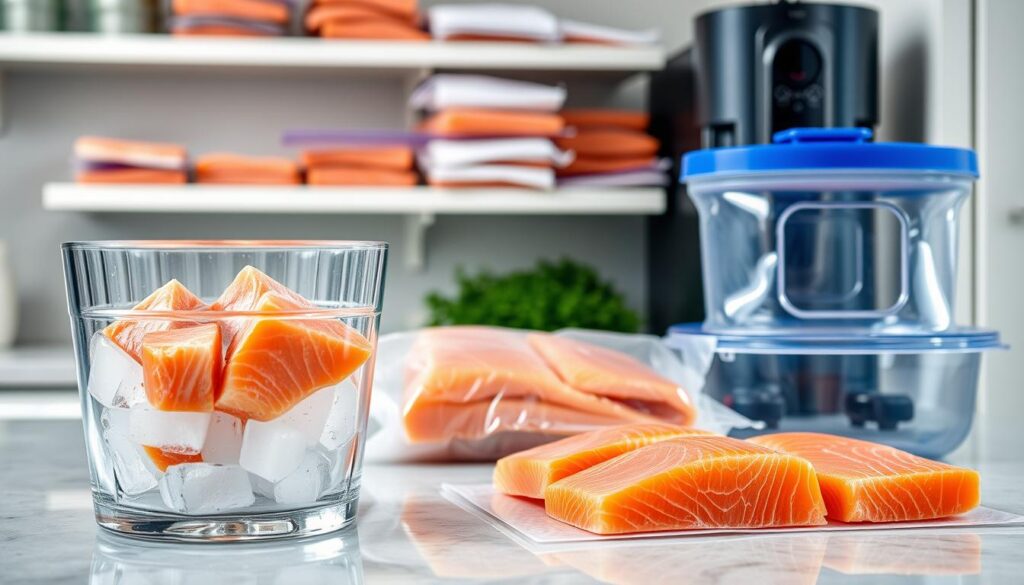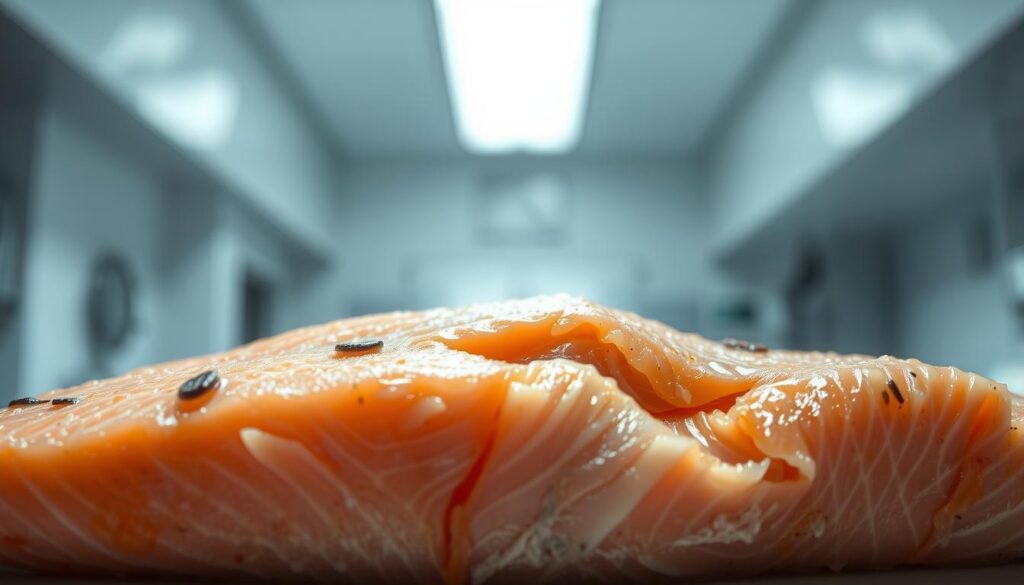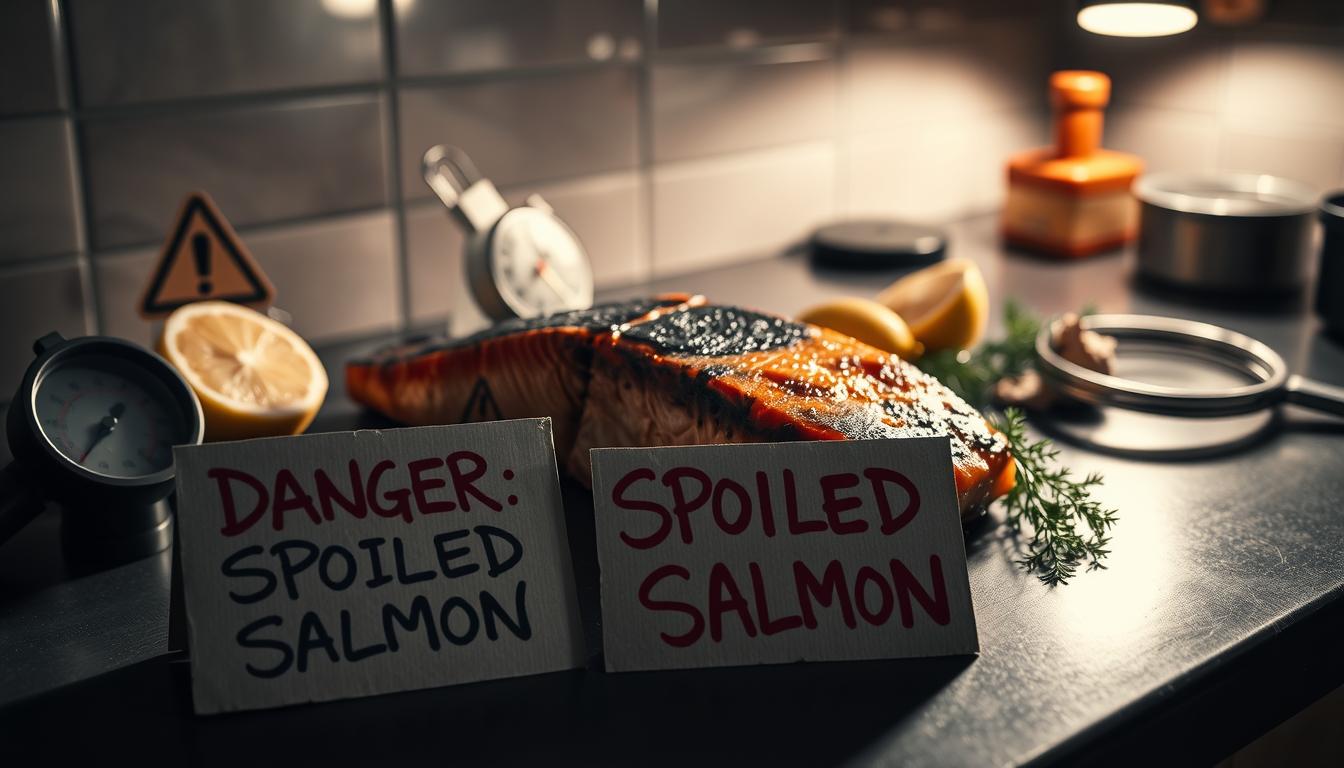Signs Salmon Is Bad: How to Check Before Eating
The last time I bought salmon for a family dinner, I learned a hard lesson. My mother-in-law’s worried look when I pulled the fillet from the fridge was a wake-up call. It showed me how important it is to check if salmon is spoiled before serving it.
Knowing if salmon is bad is more than just about taste. It’s about keeping your family safe. Spoiled salmon signs can be easy to miss, but spotting them is key. Raw seafood needs careful checking to avoid foodborne illnesses that could ruin a meal.
This guide will teach you how to check salmon’s freshness. You’ll learn to spot spoiled salmon signs before they become a problem. From looking at its color and smell to doing smell tests, you’ll become an expert at keeping your meals safe and tasty.
Table of Contents
Understanding Salmon Freshness Basics
It’s important to know if salmon has gone bad to ensure food safety and enjoy a tasty meal. Salmon is a delicate fish that needs careful handling and storage. This helps keep it fresh and prevents spoilage.
Fresh salmon is not only nutritious but also delicious. Yet, it can spoil quickly if not stored right. Salmon spoilage happens when bacteria grow, enzymes break down the fish, and oils oxidize.
Why Salmon Goes Bad
Several factors lead to salmon deterioration:
- Bacterial growth
- Enzyme breakdown
- Oxidation of fish oils
- Temperature fluctuations
Optimal Storage Temperature
Controlling temperature is key in checking salmon freshness. The USDA says to keep fresh salmon at 40°F or below. This slows down bacterial growth and keeps the fish fresh.
| Storage Location | Temperature | Maximum Storage Time |
|---|---|---|
| Refrigerator | 40°F or below | 1-2 days |
| Freezer | 0°F | 3-8 months |
Safe Storage Duration
The shelf life of your salmon depends on how you store it. Raw salmon usually lasts 1-2 days in the fridge. Frozen salmon can stay good for months if sealed well and kept at a steady temperature.
Learning these basics helps you check if salmon is fresh. It also keeps you safe from foodborne illnesses.
Visual Indicators of Spoiled Salmon
Knowing how to spot spoiled salmon is key to avoiding foodborne illness. Your eyes play a big role in deciding if salmon is good to eat. Fresh salmon is bright pink-orange and has shiny, silver skin that looks appealing and healthy.
When comparing fresh to bad salmon, look for these important signs:
- Color changes: Fresh salmon should be a consistent, bright pink-orange color
- Gray or dull patches mean it might be spoiled
- Discolored or brownish areas are warning signs
The salmon’s skin also tells you a lot about its freshness. Healthy salmon has a shiny, silvery look. As it goes bad, the skin might get dry, discolored, or feel filmy. These signs help you avoid eating bad seafood.
Experts say to do a thorough visual check. Look for:
- Uniform color distribution
- No dark or green-tinged spots
- Texture that’s consistent without unusual marks
Your eyes can spot salmon spoilage early, before other signs show up. Trust what you see and throw away the fish if unsure. This keeps you safe from health risks.
How to Know if Salmon is Bad: Essential Safety Checks
Checking salmon quality is key for your health and dining joy. Learning to inspect salmon can prevent foodborne illnesses. It ensures you eat fresh, safe seafood.
Spotting bad salmon needs a careful method. Chefs and food experts suggest several ways to check salmon’s freshness before cooking or eating.
The Press Test Method
The press test is a good way to check if salmon is fresh. Fresh salmon should have these traits:
- Firm flesh that springs back when gently pressed
- No indentation remains after touching the surface
- Consistent texture without soft or mushy spots
Surface Examination Tips
Looking at the salmon’s surface is also important. Watch out for these signs:
- Avoid salmon with a slimy or sticky surface
- Check for any discoloration or unusual patches
- Inspect for signs of browning or drying around edges
Color Assessment Guide
Color tells a lot about salmon’s freshness. Fresh salmon usually has a bright, even color:
- Bright pink or orange-red for most salmon varieties
- Uniform coloration without pale or dark spots
- Avoid salmon with grayish or brownish tints
By learning these safety checks, you can pick and prepare top-quality salmon for your meals.
The Role of Smell in Detecting Spoiled Salmon
Your nose is a powerful tool for spotting bad salmon. Fresh salmon smells like the ocean, mild and almost neutral. If you notice a rotten smell, it’s a warning.
It’s key to know when salmon has gone bad by its smell. Fresh salmon smells light and clean. Bad salmon, on the other hand, smells different and can be dangerous.
- Ammonia-like smell: A strong, sharp odor indicates bacterial growth
- Sour or fishy odor: Suggests the salmon is no longer safe to consume
- Overpowering ocean smell: More intense than a fresh, clean marine scent
Trust your sense of smell when checking salmon. If it smells bad or too strong, throw it away. The smell is a warning about foodborne illnesses.
Experts say to always smell salmon before cooking or eating it. Your nose can spot spoilage before you see it. This helps avoid health risks.
Texture Changes That Signal Spoilage
Knowing how to check the texture of salmon is key to knowing if it’s safe to eat. Fresh salmon should feel firm and smooth. It should spring back when you touch it. Spoiled salmon shows signs through changes in texture that tell you it’s time to throw it away.
Spotting spoilage means looking closely at the salmon’s surface and feel. Experienced cooks know that some texture changes can mean the fish isn’t safe to eat.
Slimy Surface Detection
A slimy film on the salmon is a clear sign it’s gone bad. If you touch it and feel a sticky, gooey layer, throw it out right away. This sliminess comes from bacteria growing and breaking down the fish’s proteins.
Flesh Firmness Test
Fresh salmon should be firm and springy. Here’s how to check:
- Gently press the salmon with your finger
- Check if the flesh springs back quickly
- Look for any permanent dents
Identifying Mushy Spots
Mushy or soft spots in salmon are big warning signs. If the flesh is no longer firm and feels soft or breaks apart, it’s gone bad.
| Texture Indicator | Fresh Salmon | Spoiled Salmon |
|---|---|---|
| Surface | Smooth, clean | Slimy, sticky |
| Firmness | Tight, resilient | Soft, breaks easily |
| Color | Bright, consistent | Dull, discolored |
If you’re unsure about your salmon, it’s best to throw it away. Your health is more important than saving money on possibly bad seafood.
Proper Storage Guidelines for Fresh Salmon

Keeping salmon fresh is all about the right storage. First, learn how to store your fish right. The secret is to keep it cool and away from air.
Here’s what to do for fridge storage:
- Store salmon at 40°F or below
- Keep it in the coldest part of your fridge
- Use it within two days of buying
Knowing if salmon is bad starts with good storage. Wrap it tightly in plastic or in an airtight container. Pro tip: Put the wrapped salmon on ice in a sealed container for the best freshness.
Freezing is great for longer storage:
- Wrap salmon in freezer-grade plastic wrap
- Put it in a freezer-safe bag, squeezing out air
- Freeze at 0°F for up to three months
Before freezing, check these salmon freshness tips. Look for any color changes or odd smells. Only freeze salmon that’s super fresh for the best taste later.
Different Types of Salmon and Their Shelf Life
Knowing how long salmon lasts is key for keeping it safe and fresh. Each type of salmon needs its own storage method. This ensures it stays good and doesn’t spoil.
Salmon comes in many forms, each with its own storage needs. Storing it right helps you know if it’s gone bad.
Raw Salmon Storage Guidelines
Raw salmon has the shortest shelf life. It needs careful handling. Store it in the fridge at 40°F or below. Raw salmon is safe to eat for:
- 1-2 days in the fridge
- Up to 3 months when frozen
Cooked Salmon Preservation
Cooked salmon can be stored for longer. Here’s how to keep it fresh:
- 3-4 days in an airtight container in the fridge
- Up to 2 months when frozen
Smoked Salmon Storage Insights
Smoked salmon lasts the longest. Unopened packages can stay good for:
- 2-3 weeks in the fridge
- Up to 6 months when frozen
Always check the salmon’s color, smell, and texture before eating. This ensures it’s safe and fresh.
| Salmon Type | Refrigerator Storage | Freezer Storage |
|---|---|---|
| Raw Salmon | 1-2 days | 3 months |
| Cooked Salmon | 3-4 days | 2 months |
| Smoked Salmon | 2-3 weeks | 6 months |
Pro tip: Always store salmon in the coldest part of your fridge. Use airtight containers to keep it fresh.
Health Risks of Consuming Spoiled Salmon

Eating spoiled salmon can lead to serious health issues. It’s not just a simple stomach upset. Knowing the risks is key to keeping you and your family safe from foodborne illnesses.
When you eat spoiled salmon, you might feel:
- Severe nausea and vomiting
- Intense abdominal cramps
- Persistent diarrhea
- High fever
- Potential dehydration
Some groups are more at risk from spoiled salmon. These include:
- Pregnant women
- Young children
- Older adults
- Individuals with compromised immune systems
The main danger is bacterial contamination. Bacteria like Listeria, Salmonella, and E. coli can grow fast in bad salmon. This turns a safe meal into a health risk.
| Pathogen | Potential Health Impact | Typical Symptoms |
|---|---|---|
| Listeria | Severe infection | Fever, muscle aches, neurological symptoms |
| Salmonella | Gastrointestinal distress | Diarrhea, fever, stomach cramps |
| E. coli | Potential kidney complications | Bloody diarrhea, severe abdominal pain |
Stay safe by checking salmon carefully and storing it right. Always trust your senses to spot bad salmon. If unsure, throw it away to protect your health.
Best Practices for Salmon Purchase and Transport
Choosing the right salmon starts with a smart buying and transport plan. A good salmon freshness test begins at the store. This ensures you get the best seafood.
When picking fresh vs bad salmon, keep these tips in mind:
- Look for bright, vibrant coloration without dull or discolored patches
- Check for firm, elastic flesh that springs back when gently pressed
- Ensure no strong, fishy odors are present
- Verify the fish is displayed on fresh ice or in properly refrigerated cases
Transporting salmon needs careful planning. Use an insulated cooler or a high-quality thermal bag with ice packs. This keeps the fish at safe temperatures during transport.
| Transportation Method | Temperature Range | Recommended Duration |
|---|---|---|
| Insulated Cooler | 32-38°F | Up to 2 hours |
| Thermal Bag with Ice Packs | 35-40°F | Up to 1 hour |
Experts say buy salmon from trusted places with lots of turnover. Always ask about the catch date and request the freshest available option. Follow these steps to get top-notch, tasty salmon.
Conclusion
Knowing if salmon is bad is key to keeping you healthy and enjoying tasty seafood. By looking for visual changes, texture, and smell, you can tell if salmon is good to eat. The tips we’ve shared help you spot spoilage.
Keeping salmon fresh is also important. Use the fridge, handle it carefully, and eat it quickly to stop bacteria. If you’re unsure, trust your senses. A little caution can keep you safe from foodborne illness.
Being careful about salmon quality can really help with food safety. Fresh salmon should look bright, smell mild, and feel firm. By using the tips from this guide, you’ll get better at picking, storing, and checking salmon. This will make cooking seafood a breeze.
Food safety is more than just following rules. It’s about knowing the details of fresh food. With these salmon skills, you’ll enjoy this healthy protein with confidence and skill.
FAQ
How can I tell if salmon has gone bad?
What does fresh salmon typically look like?
How long can salmon be stored in the refrigerator?
What does bad salmon smell like?
Can I eat salmon that has been in the fridge for a week?
What health risks are associated with eating spoiled salmon?
How should I store salmon to keep it fresh longer?
Can I tell if salmon is bad by its texture?
There are no reviews yet. Be the first one to write one.

